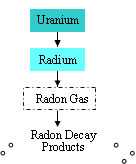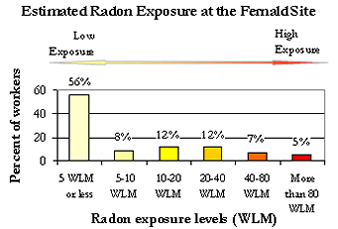Worker Health Study Summaries
Research on long-term exposure
Radon Exposures to Workers at the Fernald Feed Materials Production Center
March 2008
Study Background
This study estimated radon exposure to people working at the Fernald Feed Materials Production Center (Fernald). The Fernald site produced uranium products for use in Department of Energy defense programs. Based on study findings, researchers believe more than half of Fernald workers were exposed to a low level of radon.
Where does radon come from?

Uranium is a radioactive metallic mineral. It is found naturally in soil, rocks, and water. When processing uranium ore, many by-products are created. Radium-contaminated waste is one by-product. Radium breaks down into radon gas, which breaks down further into radon decay products. When radon gas or decay products are breathed in, decay products can get trapped in the lungs. As the decay products continue to break down, they release energy which can damage the lungs. Over time, this can cause lung cancer.
Why is radon a concern?
Past studies have found a higher-than-expected amount of lung cancer deaths among Fernald workers compared to the U.S. general population (Cragle, 1996). Because radon may lead to lung cancer, researchers wanted to estimate the levels of exposure to radon at the site.
Radium-contaminated waste, a source of radon, was stored on the west side of the site, in the K-65 silos. Another source of radon was found in the center of the site, in the Q-11 silos near the production area. It was estimated that large amounts of radon were released from these silos.
Who did this study?
The National Institute for Occupational Safety and Health (NIOSH), a federal research agency, works to improve the health and safety of workers. NIOSH gave funds to Drs. Susan Pinney and Richard Hornung, researchers at the University of Cincinnati, to do this study. These researchers used the funds to estimate radon exposure among Fernald workers from 1952 to 1988, when production stopped.
Who was in the study?
This study included 7,143 workers who worked at the Fernald site any time between 1952 and 1988. Though site operation began in 1951, there was no source for radon exposure that year.
Detailed work history information was collected from 2,666 Fernald workers through surveys, interviews, and the Fernald Workers’ Medical Monitoring Program. This information was used to figure out work information for other 4,477 workers who had worked at the site during this time.
How was radon exposure estimated?
Workers were not monitored for radon exposure, so exposure levels had to be estimated. Researchers did this by first estimating the amount of waste that was stored in the silos. They also measured the levels of radon decay products throughout the site. This information was put into a math model that estimated radon exposure for each work area and work shift. Researchers then decided usual work areas and work shifts for everyone at the site.
Researchers also looked at wind speed and wind direction at the site because both can affect radon levels. Radon exposure is generally higher downwind of a radon source or when there is little air movement.
What were the radon exposure levels?

Graph 1: Researchers believe more than half of workers had low level exposure to radon (less than 5 WLM) during their term of employment at Fernald. For comparison, the U.S. general population is exposed to an average of 0.2 WLM of radon at home each year.
When talking about exposure levels, researchers refer to them in units of Working Level Month (WLM). A WLM is a unit of measure that involves time spent near different radon concentrations.
Researchers believe radon exposure among Fernald workers ranged from very low (less than 0.5 WLM) to high (751 WLM). More than half of the workers at Fernald had low level exposure to radon (less than 5 WLM) during the time they worked at the site (see graph 1). For comparison, the U.S. general population is exposed to an average of 0.2 WLM of radon at home each year.
What were the study limits?
Researchers had information on exact work area and work shift for only one-third of the workers at the site. Because of this, researchers had to use the available worker information to approximate work areas and work shifts for workers from the site who had no information.
Wind information at the site was only available from 1987-1991, but was used to compute radon estimates for all the years in the study.
What should you do?
If you are concerned about your possible exposure to radon, participate in one of the medical screening programs offered to Fernald workers, or share this info with your doctor.
Radon exposure and smoking have each been found to cause lung cancer. But radon exposure combined with smoking makes for an especially serious health hazard. A smoker who is exposed to radon has a much higher chance of lung cancer. If you smoke, quitting is one way to lower your chance of developing this disease.
Additional Information
This study was funded by the NIOSH Occupational Energy Research Program (OERP). To learn more or to get a copy of this worker notification, visit: www.cdc.gov/niosh/oerp/
or call 800-CDC-INFO
To learn more about radon, visit www.epa.gov/radon/
To learn more about how to quit smoking, visit the online American Cancer Society’s Guide to Quitting Smoking.
Medical screening programs available to former Fernald workers:
- Fernald Worker Medical Monitoring Program (FWMMP)
To learn more, call 513-870-0900 - Building Trades National Medical Screening Program
To learn more, visit www.btmed.org or call 800-866-9663 - Worker Health Protection Program (WHPP)
To learn more, visit www.worker-health.org or call 513-367-1333
Fernald Workers’ Expert Panel
The Panel assists Fernald workers who are making a claim to the Ohio Bureau of Worker Compensation by gathering necessary workplace exposure records and providing them with a physician expert opinion report. To learn more about the Panel, call 513-381-6788.
Illness Compensation Program
If you have developed an illness you think might be related to exposure from working at a Department of Energy (DOE) site or DOE contractor facility, you could be eligible for benefits under the Energy Employees Occupational Illness Compensation Program Act of 2000 (EEOICPA). To learn more about EEOICPA, visit www.dol.gov/esa/regs/compliance/owcp/eeoicp/main.htm. To learn more about the NIOSH Office of Compensation Analysis and Support, visit www.cdc.gov/niosh/ocas.
Centers for Disease Control and Prevention (CDC)
CDC is the federal agency that works to promote health and quality of life by preventing and controlling disease, injury, and disability. To learn more, visit www.cdc.gov or call 800-CDC-INFO.
National Institute for Occupational Safety and Health (NIOSH)
NIOSH is the federal agency within CDC that is responsible for conducting research and making recommendations for the prevention of work-related injury and illness. To learn more, visit www.cdc.gov/niosh.
Publications
Study Publication
Hornung RW, Pinney SM, et al. Estimation of radon exposures to workers at the Fernald Feed Materials Production Center 1952-1988. Journal of Exposure Science and Environmental Epidemiology 2008; 1-12. NIOSHTIC-2 link: www2a.cdc.gov/nioshtic-2/BuildQyr.asp?s1=20034182
Related Publication
Cragle DL, et al. Mortality among a cohort of white male workers at a Uranium processing plant: Fernald Feed Material Processing Production Center, 1951-1989. Center for Epidemiological Research, Oak Ridge Institute for Science and Education. Final Report, 1996.
- Page last reviewed: April 11, 2017
- Page last updated: July 13, 2012
- Content source:
- National Institute for Occupational Safety and Health (NIOSH) Division of Surveillance, Hazard Evaluations, and Field Studies.


 ShareCompartir
ShareCompartir